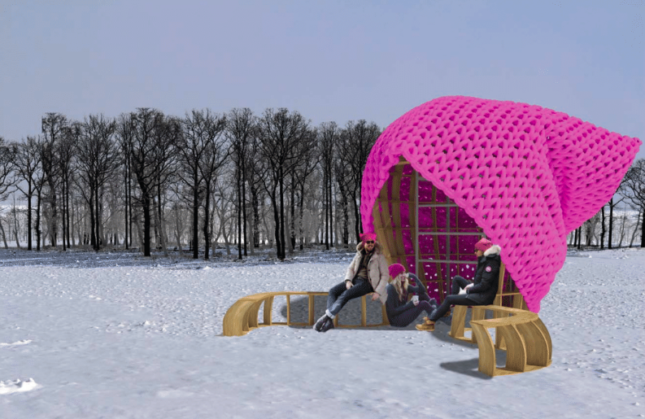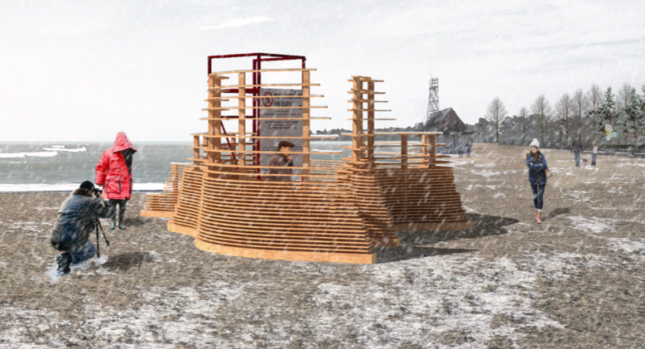Canadian winter design devotees have selected four winning designs to spiff up Toronto’s east end beaches this February. The fourth annual Winter Stations International Design Competition asked entrants to consider the succinct theme, RIOT, when dreaming up installations that sit around the beaches’ not-used-much-in-winter lifeguard stations.
Some of the winners took the theme literally, and the others reflected more abstractly on the global political chaos, struggle, and strife that defined 2017. The United States’ Martin Miller and Mo Zheng’s sheltering Pussy Hat nods to the knit hats women (and some men) donned in protest after President Donald Trump’s election, while Alexandra Grieß and Jorel Heid of Germany brought an, um, alarming new take on Italian Futurist Luigi Russolo’s intonarumori to the waterfront with their installation, Make Some Noise!!! In Wind Station, Paul van den Berg and Joyce de Grauw of the Netherlands advocate for nuclear phase-out using hundreds of pinwheels—wind energy—assembled in the shape of a nuclear cooling tower. Kien Pham’s Obstacle strikes a more optimistic note. The U.K. designer installed red barriers around a climbing piece that can be accessed only when visitors work in teams to rotate the barriers.
“It was important for us to allow the competition to evolve and reflect the global events of the past twelve months,” said Winter Stations co-founder Roland Rom Colthoff of RAW Design, in prepared remarks. “At the same time, the installations couldn’t stray too far from the main motive of Winter Stations, which is to bring joy, warmth and conversation to the long, cold Canadian winter landscape.”
Three student installations will join the four professional designs. Students will erect their own projects, while the build team from Anex Works will construct the pros’ pieces.
Competition founders RAW Design, Ferris + Associates, and Curio conceived the event as a way to get Torontonians to the beach in the chilliest months.
The seven structures will be erected at Kew, Scarborough and Balmy beaches. Opening day is February 19, and the installations will be on view until April 1. Can’t make it to Toronto? Feat not—renderings of the winning designs are reprinted here. (All text is via the Winter Stations International Design Competition project descriptions.)

“Inspired by the Women’s March movement, this vivid installation recreates the powerful, knitted symbol that captured the spirit of the protests around the world on January 21, 2017. The design is simple, yet powerful, a symbol that gains strength through participation and unity. As winter approaches it is a reminder to wear your hat, stand up for what’s right, and stay warm.”

“Italian Futurism comes to Toronto with this over-sized noisebox, based on Luigi Rusollo’s ‘intonarumori’ which caused an uproar in the classical music scene when he introduced it in the Milan Opera House in 1914. The installation is intended as a playful instrument to ‘ring the alarm.'”

“Wind Station is a call for nuclear phase-out that brings together hundreds of tiny pin-wheels, to symbolize renewable wind energy, in the shape of a nuclear cooling tower. A playful protest that asks why countries continue to rely on dangerous and un-sustainable technology to provide energy when safer, cleaner alternatives are available.”

“Obstacle is a metaphor for overcoming the problems in the world. Although at first, it seems like an impenetrable barrier, the columns rotate allowing visitors to enter and interact with the obstacle, and other visitors. In order to confront the obstacle, visitors have to work together, rotating the columns in sequence to overcome the adversity.”

“Inspired by the topography of Toronto’s Don Valley, Rising Up invites visitors to experience nature’s uprising against increasing urbanisation. The elevating tension between humans and the environment is articulated through deconstructed topographical layers and increasing negative space within the sculpture which exposes visitors to the elements.”
The project team includes Alexander Good, Austin Huang, Kevin Sadlemyer, Marc Cote, Stephan Stelliga, Zixiang Chen, BLA students, University of Guelph, School of Environmental Design and Rural Development and Nadia Amoroso, PhD, ASLA, Faculty Representative, University of Guelph, School of Environmental Design and Rural Development.

“NEST is an installation that embodies ideas of comfort within a system of disorder and complexity. The structure is composed of modular cells that contain a weave of colourful webs, providing both shelter and playful moments of light and shadow within the space.”
The project team is Adrian Chiu, Arnel Espanol, and Henry Mai.

“Revolution is composed of 36 vertical modules of different height, enabling visitors to express their opinions through the air. As one projects their voice into the horn, they also amplify the conviction of their words. As the wind blows through the installation, it carries these sounds and ideas into the atmosphere to form a collective message.”
The project team includes Ben Chang, Anna Pogossyan, Amr Alzahabi, Carlos Chin, Iris Ho, Tracee Jia, Krystal Lum, Adria Maynard, Purvangi Patel, and Judiette Vu.











